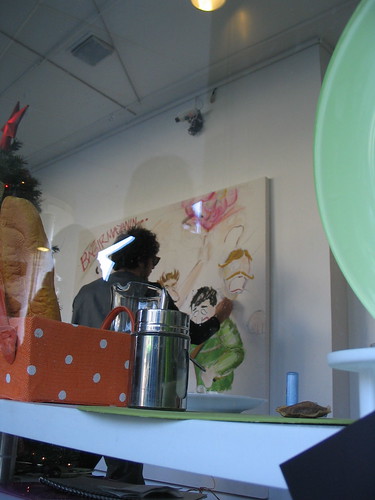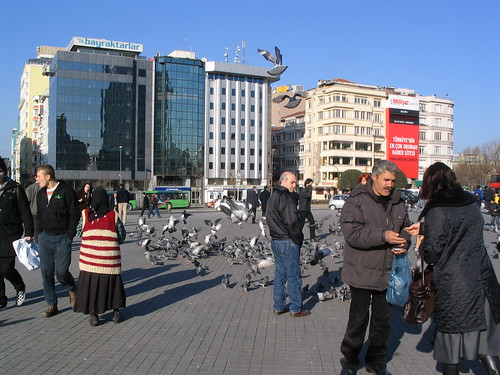
In a commercially condensed version of Ed-TV, a 22-year old Istanbul design student recently spent one week of his life in the shop window of the Sisli YKM department store - under constant surveillance by both passerbies and internet visitors to the corresponding website - in an advertisement installation called "Vitrindeki Cocuk" - The Guy in the Store Window.
The project lasted for one week - conveniently coinciding with the week before New Years - a very heavy shopping time of year in Istanbul. Families out doing their last minutes holiday shopping in the shopping area of Sisli - which includes Cevahir, the largest shopping mall in Europe, and several clothing, shoe, and electronic stores - were awe struck by such a sight, stopping to watch the "guy in the shop window". His temporary home is equipped with several goods from the department store itself - a fully stocked kitchen, fashionable clothing, flat screen TV, and a New Year's tree.
At the start of the project, the anonymous "Guy in the shop window" exhibited much excitement,
quoted in the Turkish Daily News saying "I am very excited and I think I will get used to living here...I don't know how I will be and what people will do when they encounter me on the street after I get out of here."
By the time I visited on the 6th day of the project, however, he seemed a bit less excited. As I walked down the sidewalk to the popular Turkish department store, I saw the crowd gathered around the window. He was drawing a colorful, flowing picture of people yelling and banging drums. In red he had written
Bağırmayının... - "Don't shout..." This taunted the psychology of the children viewing the installation, who ran around screaming, "He wrote 'Don't shout!', he wrote 'Don't shout!'"
His face had been made into a icon, advertising the corresponding website vitrindekicocuk.com, and posters declared that the installation was sponsored by several Turkish and international companies. The cameras in the installation captured "guy" from four angles - but simultaneously captured those viewing him, updating to the website in real time.

The installation certainly encourages the viewer to interact with "Guy," both through the online home of the project and at the project itself. A button on the wall states "Push the button to speak with the "Guy in the shop window." A young girl kept running up to the button, pushing it, and attempting to taunt the guy before tumbling into laughter and running to her friend's side. "What are ya gonna do tomorrow, man?" she asked him, squealing. He spent half his time ignoring her and half glaring. A security guard told the girl not to bother him. "But it says push the button to talk to him!" she said, dashing over to push it again.

Walking up and down the window, snapping pictures of the window and the viewers, I felt no less an intrusion than that young girl. I just found myself hoping "Guy" would not turn around and pose, dragging me into the circus. Of course photographing a scene behind a window is not easy, and even from the best angles it is difficult not to end up taking a photograph of your unsuspecting self (Or, the mosque in the background, as you can also see in this photo).
It would be an exaggeration to say, however, that the glorified commercial was or inspired an inquiry of the self and the other, the viewer and the viewee, the observer changing that which is observed. Perhaps it was the icon of the "Guy in the Shop Window" plastered next to the adidas and Chanel ads, or the bright orange sign "He sleeps in the store window, he wakes up in the store window, he eats in the store window, he watches TV in the store window! He lives with the YKM products in the store window 24/7," and the clean row of shoes waiting to be voted for Guy's outfit of the day - or to be purchased by holiday consumers.
In contrast to most of the shoppers stopping by, I actually took the bus to Sisli for the sole purpose of seeing this living, breathing advertisement in context. While my trip there was motivated by visions of some sort of pop-sociology experiment, the seamless integration of the the New Year's shopping rush with the lean-lanky design student in sunglasses left me instead contemplating my affinity to such guilty pleasures - reality TV trends, shopping, and aesthetically pleasing advertising!
 Photo from Wikipedia
Photo from Wikipedia






